Effective Bluebird Pest Control Strategies and Insights
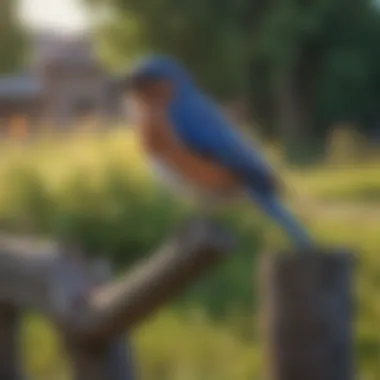
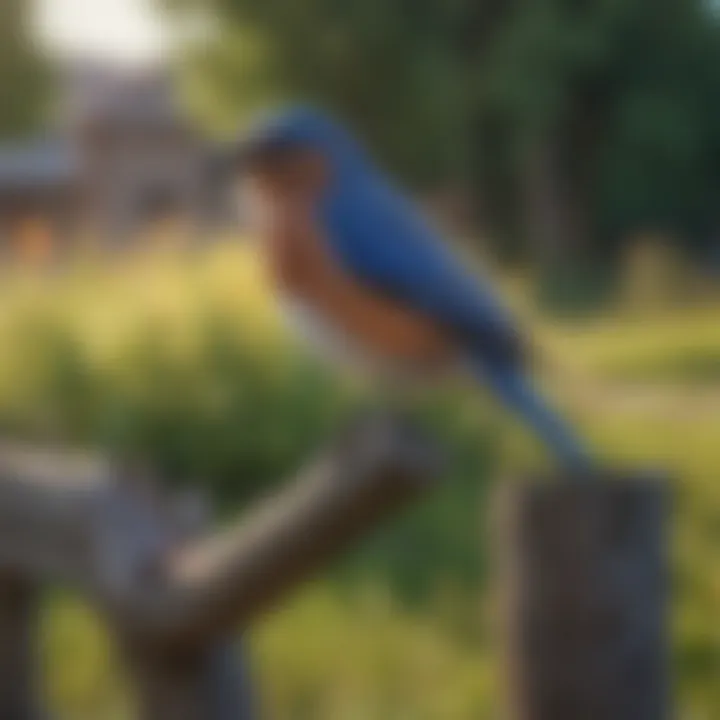
Intro
In the delicate dance of agriculture, the interplay between crops and pests can often feel like an uphill battle. Farmers and horticulturists alike strive to manage pest populations without disrupting the fragile ecological balance that sustains life in their fields. One strategy that has emerged prominently in recent years is the utilization of bluebirds as natural pest controllers. Not just charming inhabitants of gardens, these avian allies play a pivotal role in maintaining the health of agricultural ecosystems. This article will unravel the layers behind bluebird pest control, guiding both seasoned professionals and enthusiastic newcomers in understanding the nuanced relationships that can exist between these birds and pest management strategies.
By examining the concepts, historical context, and recent innovations in bluebird pest control, readers will gain valuable insights into how these birds can contribute to sustainable agricultural practices. The relevance of this approach lies not only in managing pests but also in achieving an equilibrium that promotes biodiversity while ensuring robust crop yields.
Key Concepts and Terminology
Understanding the foundation of bluebird pest control requires grasping essential concepts and terminology associated with this practice.
Basic Definitions
- Pest Control: The management of species deemed harmful to crops, which includes various techniques aimed at minimizing their impact on agricultural productivity.
- Ecological Balance: The state of equilibrium in an ecosystem where species coexist, and environments remain healthy and productive.
Historical Context
Historically, agriculture has been intertwined with the natural behaviors of species that prey upon common pests. The fascination with using birds in pest control draws on centuries-old practices where farmers recognized the benefits of having these feathered friends around. The bluebird, specifically, has become a symbol of gardens not only for its aesthetic charm but also for its appetite for harmful insects. As farmers began to recognize the role of bluebirds, practices evolved to encourage their presence in orchards and fields.
A healthy bluebird population can reduce pest levels by up to 50%, demonstrating an effective and eco-friendly approach to pest management.
Recent Innovations and Trends
In a world that is rapidly technological, the field of pest control is constantly evolving. Recent trends highlight both traditional methods and innovative practices that harness the natural instincts of bluebirds.
Technological Advancements
Emerging technologies have enabled farmers to map and monitor bird populations more accurately. By utilizing apps and software, agriculturalists can assess bluebird nesting sites and track their activities to optimize pest control efficiently.
Sustainable Practices
Many modern farms are adopting holistic approaches that incorporate bluebirds into integrated pest management systems. This not only minimizes chemical pesticide use but also supports a thriving ecosystem crucial for long-term agricultural success. As interest in sustainable farming grows, the appreciation for bluebirds as natural allies in pest management continues to increase.
Practical Applications and Techniques
Understanding theoretical concepts is essential, but practical application can transform knowledge into effective strategies.
Step-by-step Guides
- Creating Bluebird Habitats: Install bluebird houses in fields and orchards to encourage nesting. Ensure they are spaced correctly to reduce territorial disputes.
- Monitoring Pest Populations: Keep an eye on pest figures to understand when bluebird intervention is necessary.
- Documenting Bluebird Activities: Take notes on bluebird visits and their impact on pest populations, adjusting strategies accordingly.
Case Studies
Numerous farms across the United States have reported success stories involving bluebird pest control. One such farm in Michigan implemented bluebird houses around its vegetable fields and saw a significant reduction in aphid infestations within one growing season. The targeted approach not only lessened the financial burden of pest management chemicals but also bolstered the farm's ecological integrity.
By combining traditional practices with modern innovations and understanding the role of bluebirds intricately, farming can evolve to be more sustainable while still productive. As we dive deeper into this exploration, the synergy between agriculture and nature unfolds, promising a brighter path for future generations.
Prelude to Bluebird Pest Control
The relationship between bluebirds and agricultural practices is both fascinating and fundamentally important. This section sets the stage for understanding bluebird pest control as an innovative solution to some of the ongoing challenges faced by farmers and land managers. As farmers look to adopt more sustainable methods, integrating natural pest management approaches becomes more pressing than ever.
The Role of Bluebirds in Agriculture
Bluebirds act as natural allies in the fight against agricultural pests. These vibrant birds thrive on a diet primarily composed of insects, many of which can wreak havoc on crop yields. Imagine a field buzzing with pests, causing fear for farmers everywhere; now picture a swarm of bluebirds swooping in, working diligently to snatch these little critters from the air. By fostering bluebird populations, farmers can harness the birds' natural predation to help regulate pest populations, thereby reducing the need for harmful chemical pesticides.
Not only do bluebirds provide ecological benefits, but they also add charm to the farming landscape. Their presence can indicate a well-balanced ecosystem, which is vital for healthy soil and agriculture. Furthermore, their colorful plumage and melodious songs can attract ecotourism, boosting farm revenues in ways that mere pest control cannot.
Understanding Pest Dynamics
To fully appreciate the role of bluebirds in pest management, one must first grasp the complexity of pest dynamics. Agricultural pests vary significantly, and their populations can burst forth under certain conditions like weather changes or crop rotations. In understanding these dynamics, farmers can better utilize bluebirds as a sustainable pest control strategy.
It's essential to identify not just the types of pests present but also their life cycles, breeding habits, and environmental triggers. For instance, aphids flourish in warmer conditions, while certain grasshoppers thrive after a wet season. Knowing these nuances allows farmers to optimize their environments to encourage bluebird activity when pest populations peak.
Moreover, fostering a habitat conducive to bluebird occupancy can help reduce pest populations naturally. Nest boxes, proper food sources, and minimal disturbance can keep bluebirds around to patrol the fields.
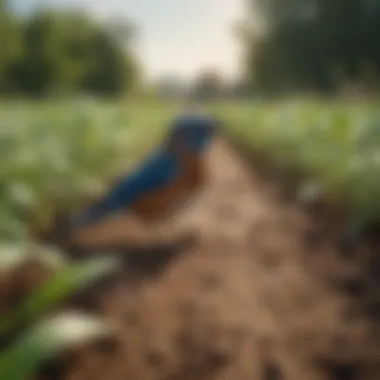
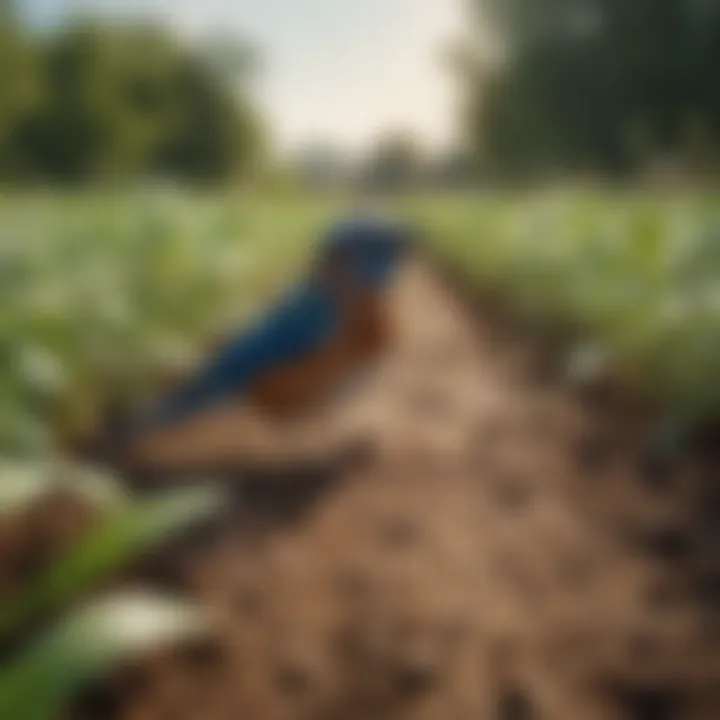
In summary, understanding bluebird pest control leads to insights not only about the birds themselves but also about the pests they help manage. This connection not only transforms pest control methods but encourages a broader conversation about the sustainability and health of farming practices today.
Utilizing bluebirds as a natural pest control agent is not just about protecting crops; it's about nurturing an ecosystem that can thrive over the long haul.
By incorporating bluebirds into pest management strategies, farmers marry the need for productivity with environmental stewardship. This dual focus ensures that agriculture can flourish while maintaining a harmonious balance with the natural world.
The Significance of Pest Control
Pest control is more than just a practice; it’s a necessity for farmers and agricultural workers striving to maintain productivity and sustainability. Pests can wreak havoc in fields, gardens, and orchards, making it essential to address the significance of pest control effectively. By leveraging natural methods, such as the presence of bluebirds, agricultural communities can not only safeguard their crops but also contribute positively to the ecosystem. It’s a win-win situation that demands attention and strategic planning.
Impact of Pests on Crop Yield
The impact of pests on crop yield cannot be understated. They can range from insects to rodents, often resulting in substantial losses to harvests. For example, aphids, known for their rapid reproduction, can invade a corn patch and ultimately stunt growth, leading to a less bountiful harvest. To illustrate:
- Corn: A single aphid can produce up to 100 offspring in just weeks, severely impacting yield.
- Wheat: Grasshoppers can eat up to 50% of a wheat field before the season's end, devastating the expected production line.
This is why understanding the dynamics of pest populations is crucial. By identifying pest types and their lifecycle, farmers can adopt timely interventions to mitigate risks. The objective should always be to strike a balance between optimizing crop yield and maintaining healthy ecosystems.
Economic Consequences of Pest Infestations
The economic implications of pest infestations extend beyond immediate crop losses. The costs include, but are not limited to, pest control measures, loss of market access due to reduced quality, and increased labor requirements for monitoring and managing the infestations. Some of the often-overlooked consequences are:
- Increased Input Costs: Purchasing pesticides can strain a farmer's budget, often leading to financial distress.
- Market Access Issues: Certain commodities suffer diminished demand if pest damage is visible, thus lowering prices or leading to rejection by buyers.
Furthermore, pest infestations can lead to a spider-web of challenges, where the repercussions spread throughout the supply chain. For instance, if a farmer experiences a crop failure due to pests, it impacts not just their livelihood but also the local economy. Supply chains feel the pinch, leading to price increases for consumers and loss of confidence in agricultural production overall.
"Understanding how to manage pests effectively is crucial not just for farmers, but for the entire ecosystem that relies on healthy crops."
Ultimately, pest control is not just about eliminating unwanted guests; it’s a strategic imperative that marries economic sense with ecological responsibility. As we explore more about bluebirds as a natural pest control solution, it becomes clear that these creatures hold potential that is well worth the consideration within agricultural practices.
Behavioral Insights of Bluebirds
The behavioral patterns of bluebirds play a significant role in their effectiveness as natural pest control agents. Understanding how these birds interact with their environment can offer insights into optimizing their presence in agricultural settings. By tapping into their natural instincts and habits, farmers and enthusiasts alike can enhance pest management strategies that are both effective and sustainable.
Feeding Habits and Preferences
Bluebirds primarily feast on various insects, such as grasshoppers, beetles, and caterpillars, making them valuable companions in pest control. Their feeding preferences are not just limited to insects; they also enjoy berries and fruits, especially during the breeding season when they need additional energy to care for their young.
Their hunting method is rather fascinating. They often perch on high vantage points, scanning for movement on the ground. When they spot a potential meal, they dive down with remarkable precision. This behavior not only helps control pest populations but also minimizes the impact of pest infestations on crops.
It's worth noting that bluebirds may prefer certain insects based on their life cycle stages. For instance, beetles in their larval state are often more appealing than as adults, as they are softer and easier to consume. Recognizing these preferences can guide farmers in creating an environment that attracts bluebirds, such as planting specific crops that coincide with bluebird feeding habits.
"A bluebird’s diet is a chased buffet of insects and fruits—knowing what tickles their taste buds can make all the difference in attracting them."
Breeding and Nesting Considerations
The success of bluebirds in agricultural areas also hinges on their breeding and nesting behaviors. They are cavity-nesters, meaning they often seek out natural holes or artificial nesting boxes. Understanding their nesting requirements can help in creating suitable habitats that encourage bluebird populations to thrive.
A few key considerations include:
- Nesting Boxes: It’s essential to provide clean, accessible nesting boxes. Positioning them in open areas, away from heavy tree cover, will make them appealing to bluebirds while keeping them safe from predators.
- Biodiversity: Maintaining a landscape rich in native plants can attract both bluebirds and the insects they prey on. Incorporating a variety of plant species ensures food availability throughout the seasons.
- Monitoring: Keep an eye on the nesting boxes. Regular checks can help in managing the health of the bluebird population and ensure that the nesting sites remain suitable for habitation.
Overall, recognizing the breeding and nesting behaviors of bluebirds can significantly boost their numbers on farmland, leading to a more effective natural solution for pest management. By fostering an environment that nurtures these birds, farmers can enjoy both increased insect control and enhanced biodiversity on their land.
Technical Aspects of Bluebird Pest Control
Understanding the technical aspects of bluebird pest control is crucial for farmers and enthusiasts alike. It goes beyond just the presence of bluebirds on a farm; it's about creating an ecosystem where these birds can thrive while effectively managing pest populations. This section will reveal the specific elements you need to consider, the benefits that come with them, and how they play a vital role in the overall strategy of pest management.
Establishing a Suitable Environment
Creating a habitat that welcomes bluebirds is essential. A suitable environment encourages nesting, feeding, and ultimately, increased bluebird populations. Here are some factors to consider:
- Nesting Sites: Install nesting boxes in open areas far from heavy tree cover. These boxes should be made from natural materials, providing insulation and safety from predators.
- Food Supply: Bluebirds are insectivores by nature. Planting native plants that attract insects will ensure they have a reliable food source. For example, wildflower patches can draw in necessary bugs.
- Water Sources: Ensure there are clean water sources nearby. Birds are drawn to open water, so shallow birdbaths or natural ponds can make a significant difference.
Decorate the environment using local flora to aid in maintaining the natural balance. This can also enhance the aesthetic beauty of the farm!


Monitoring Pest Populations
Monitoring pest populations is paramount to the success of bluebird pest control. Without accurate data, it becomes difficult to assess effectiveness or needs for intervention. The steps involved in monitoring include:
- Identifying Pests: Know what you're dealing with. Are aphids causing damage or are slugs munching on your plants? Identifying the pests can help tailor bluebird strategies effectively.
- Tracking Population Changes: Use visual surveys or traps to gather data on pest numbers over time. This can help determine if pest populations are on the rise or wane, influencing the need for bluebird involvement.
- Evaluating Bluebird Success: Note how many pests bluebirds are managing to eat. This monitoring can also help identify if there’s a need to adjust habitat conditions, food supplies, or even add more nesting boxes.
By keeping a close eye on pest trends, farmers can make timely decisions, ensuring their bluebird populations can do their jobs effectively.
Integration with Traditional Pest Control Methods
It's important to integrate bluebird pest control with traditional methods. This combined approach ensures that sustainable practices do not exclude necessary interventions. Here’s how:
- Complementing Chemical Interventions: If chemical pest control methods are already in place, consider timing your applications to minimize harm to bluebird food sources. For instance, applying pesticides during evening hours, when bluebirds are less active, can be beneficial.
- Using Physical Barriers: Set up barriers to protect crops while allowing bluebirds access to the pests. For example, row covers can shield seedlings from insects, granting bluebirds a chance to feast.
- Pest Cycle Awareness: Be aware of pest life cycles. Timing is key. If bluebirds are active during a specific season, ensure those pests are present at their peak during that time.
Integrating these methods has the potential to create a synergistic effect where all aspects of pest control work together for a sustainable farming approach.
Incorporating these technical aspects forms the bedrock of an effective bluebird pest management strategy—one that wholeheartedly values both ecological balance and agricultural productivity.
Benefits of Utilizing Bluebirds
Integrating bluebirds into pest management strategies in agriculture offers a range of compelling advantages. As natural predators, bluebirds provide a cost-effective alternative to chemical solutions. This section will explore both the financial benefits and the broader ecological advantages of leveraging these charming birds in agricultural practices.
Cost-Effectiveness Over Chemical Solutions
Utilizing bluebirds for pest control can save farmers significant amounts of money. First off, maintaining a good bluebird population can minimize the need for chemical pesticides. A rough estimate indicates that farmers who actively encourage bird populations can reduce pesticide spending by nearly 30-50%. This shift is beneficial in a couple of ways:
- Decreased chemical purchase: By using bluebirds to manage pest levels, farmers spend less on purchasing pesticides, which can sometimes come with a hefty price tag.
- Reducing application costs: Chemical application also requires labor and equipment, which can be costly. With bluebirds on the job, these costs can be trimmed down.
Moreover, protecting crops with bluebirds not only makes financial sense but also promotes healthier farming in the long run. When pests are managed naturally, the soil and surrounding ecosystem remain intact, allowing farm productivity to flourish.
Environmental Impact Considerations
When farmers think about pest control, the environmental implications can't be ignored. Chemical pest solutions often lead to soil degradation and water contamination. In contrast, bluebirds contribute positively to their environments. They feed not only on harmful insects but also on other pests that do not directly threaten crops, such as grubs and caterpillars. This selective feeding behavior helps maintain a balanced ecosystem on farms.
A few notable positive environmental impacts include:
- Reduced chemical runoff: By minimizing or eliminating pesticide use, farmers help to protect nearby water bodies from contamination.
- Soil health improvement: Chemicals can adversely affect soil organisms. By promoting bluebird populations, farmers can foster healthier soil microbiomes through reduced chemical interventions.
The ripple effect of these choices leads to better agricultural practices and resilient ecosystems, thus nurturing sustainable farming paradigms.
Promoting Biodiversity on Farms
Encouraging bluebirds on farms isn’t just about pest control; it also plays a pivotal role in supporting biodiversity. Bluebirds themselves are part of a broader system of organisms that interact in complex ways. Here’s how fostering these birds can positively impact biodiversity:
- Attracting other beneficial species: Establishing a habitat for bluebirds can likewise draw in other beneficial wildlife, such as pollinators like bees and butterflies, who are crucial for many crops.
- Habitat enrichment: Nesting boxes and natural habitats created for bluebirds can support other species like native insects and small mammals, creating a thriving ecosystem on the farm.
- Creating stability in agriculture: Increased biodiversity can lead to clearer pest dynamics, which means that pest problems may be minimized before they escalate into full-blown infestations.
The end result? A farm environment that thrives on resilience, showcasing the beauty of interdependence in nature. Bluebirds act as a conduit for this diversity, ultimately creating a rich agricultural tapestry.
"By nurturing bluebirds, farmers nourish the land and all its inhabitants. A vibrant ecosystem reflects resilience."
Challenges in Bluebird Pest Control
Bluebird pest control can be an effective natural approach to managing pest populations in agricultural settings. However, it doesn’t come without its hurdles. Understanding these challenges is crucial. Many farmers and enthusiasts might assume that simply encouraging bluebirds will resolve their pest problems. But, multiple factors can influence their effectiveness, including environmental conditions, species interactions, and climate shifts. By examining these elements, we can gain insights on how to better support bluebird populations while optimizing their role in pest management.
Habitat Loss and Fragmentation
One of the main challenges bluebirds face is habitat loss. As urban areas expand and agricultural practices intensify, the natural environments that bluebirds thrive in are diminishing. Fields turned into monocultures or developed for housing not only displace the birds but also reduce the availability of insects necessary for their diet.
Additionally, fragmentation of habitats makes it tough for bluebirds to locate nesting sites and suitable food sources. They rely on open, grassy areas mixed with scattered trees or shrub cover, typical of rural landscapes. When these landscapes are broken into smaller patches, population connectivity decreases, leading to a decline in genetic diversity.
This fragmentation can turn a vibrant ecosystem into a series of isolated islands, leading to what some ecologists might call an "ecological echo chamber". Without larger contiguous spaces, bluebirds may struggle to find the food and shelter they need for successful breeding.
"In the realm of pest control, fostering the right environment is just as pivotal as the presence of the pest-eaters themselves."
Here are some practical ways to combat habitat loss:
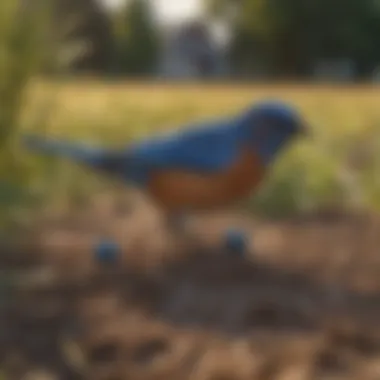

- Plant native shrubs and trees. These provide nesting materials and food sources.
- Establish conservation areas. This helps retain larger spaces with fewer disturbances.
- Promote practices to maintain diversity, like polyculture, rather than monoculture cropping.
Competition with Other Species
Competitive dynamics within the avian community also hinder bluebird efficacy as pest controllers. For instance, other birds, such as house sparrows and starlings, can outcompete bluebirds for nesting spots. These aggressive species often prevail in urban or suburban environments where bluebirds could ideally thrive.
These competitors can quickly take over man-made nesting boxes, which bluebirds depend on heavily for raising their young. As a result, even with an adequate insect population, the bluebirds might have nowhere to go, which could affect their breeding success. Hence, the overall pest control potential of bluebirds is hampered, leading farmers to seek alternative solutions out of frustration.
Simple strategies to support bluebirds include:
- Proper placement of nesting boxes to deter other species.
- Regular maintenance of existing nesting sites to ensure they're attractive to bluebirds.
- Promoting a diverse bird community that indirectly supports bluebirds, decreasing pressure from more competitive species.
Climate Change Effects
Climate change adds another layer of complexity to the challenges of bluebird pest control. Changes in temperature and precipitation patterns can alter the availability and timing of the insects that bluebirds rely on, impacting their feeding efficiency and reproductive success. Nemesis is when the temperature shifts cause peak insect populations to occur outside of the bluebirds' breeding season, reducing available food for raising chicks.
Moreover, shifting climates may lead to the emergence of new pest species. These pests may not be effectively managed by bluebirds, pushing farmers more toward chemical solutions, which ultimately impacts the health of both wildlife and the ecosystem.
To counteract the effects of climate change, some adaptive measures include:
- Monitoring pest dynamics to understand patterns and prepare accordingly.
- Creating more resilient landscapes through sustainable agricultural practices.
- Participating in local conservation efforts aimed at climate adaptation such as reforestation.
Understanding these challenges is essential to successfully harness the potential of bluebird pest control. By addressing habitat issues, mitigating competition, and adapting to climate variability, we can create a more supportive environment for bluebirds, paving the way for more balanced pest management strategies.
Encouraging Bluebird Populations
Bluebirds play a subtle yet pivotal role in pest management within agricultural landscapes. It’s no secret that these captivating birds are not just a delight to our eyes but also serve as invaluable allies against pests. Encouraging bluebird populations can profoundly influence the natural balance, promoting healthier crops and fostering a sustainable environment. However, recognizing the significance of these actions is paramount for any farmer or horticulturist.
Creating Nesting Boxes
One of the simplest ways to attract bluebirds is by providing suitable nesting boxes. Nesting boxes not only offer a safe haven for bluebirds but also increase the chances of their successful breeding. These carefully designed structures can be placed strategically throughout farmlands. Consider using untreated wood, like cedar or pine, to create these homes, ensuring ventilation holes for comfort.
- Size matters: A standard box should be about 5x5 inches at the base and 10 inches tall.
- Placement is key: Position them at least 100 feet apart, ideally facing an open area, to reduce competition among birds.
- Monitor regularly: Regular checks will help avoid any predation or dampness issues inside the boxes.
"Creating an inviting home for bluebirds is like rolling out the welcome mat to nature's pest control squad."
Providing Food Sources
Just like any creature, bluebirds need a reliable food source nearby to thrive. Putting out feeders filled with mealworms or suet can entice these birds to visit regularly. Native plants that produce berries and seeds can also aid in drawing them in. Designing your farm with these elements in mind contributes to an ecosystem where bluebirds feel welcomed.
Here are some actions you can consider:
- Select native plants: Bluebirds benefit from locally adapted vegetation that blooms at different times, providing sustenance across seasons.
- Avoid pesticides: Chemicals can harm bluebirds, reducing the availability of insects they rely on for food, especially during their breeding season.
Implementing Conservation Practices
Conservation is more than just a buzzword; it’s a practice that hands nature a helping hand. Implementing conservation practices ensures that bluebirds not only arrive on your land but also thrive in it.
- Pollinator habitats: Establish areas on your farm that encourage pollinators. This fosters a balanced ecosystem where bluebirds can find plentiful food.
- Water sources: A small birdbath can attract bluebirds and other bird species. Ensure it is clean and has fresh water to provide both hydration and bathing opportunities.
- Be aware of predators: Reducing the risk of predators through habitat management can lead to healthier bluebird populations. Simple things like placing nesting boxes away from dense shrubs can work wonders.
Promoting bluebird populations within farm settings not only aids in pest control but also enriches biodiversity. By harmonizing our agricultural practices with nature's systems, we can reap the benefits of healthy crops and vibrant ecosystems.
The End and Future Considerations
The exploration of bluebird pest control emphasizes its potential within agricultural settings. Both farmers and those with an interest in sustainable practices can benefit from understanding this topic. Utilizing bluebirds not only addresses pest issues but also contributes to the ecological balance necessary for successful farming. As we look toward the future, integrating these natural pest control methods could redefine how we approach agriculture.
The Future of Pest Control in Agriculture
The evolution of pest control strategies in agriculture presents a unique fusion between traditional methods and innovative practices. In the coming years, as we witness increased pressure from pests due to climate fluctuations, the role of bluebirds may become even more crucial. Many farmers are now beginning to understand that merely relying on chemical solutions isn't sustainable.
- Natural Predation: Bluebirds can significantly reduce pest populations through their natural feeding habits. This is not only beneficial to crops but also reduces the need for harmful pesticides.
- Sustainable Practices: The future may see a rise in integrated pest management (IPM) systems, which incorporate various pest control methods, including fostering bluebird habitats. These strategies work hand-in-hand with environmental health, potentially increasing productivity and biodiversity.
- Technological Integration: Innovations such as monitoring apps for bird populations can help farmers track how effectively bluebirds are controlling pests. Using technology to bolster natural solutions might just be the game-changer needed in modern agriculture.
Collaborative Approaches to Pest Management
Collaboration will be key in advancing the role of bluebirds in pest management. Farmers, ecologists, and local communities will need to work together to maximize the benefits.
Collaboration between diverse stakeholders is essential for developing effective pest management strategies.
- Engaging Communities: Farmers who involve local communities in conservation efforts will find a willing group of allies ready to support bluebird habitats. Workshops educating others about the importance of these birds can foster wider interest and understanding.
- Research Partnerships: Connecting with universities or research institutions to study bluebird behaviors can provide valuable data. This information can enhance strategies for increasing their presence in agricultural zones.
- Policy Advocacy: Effective collaboration can also lead to more resilient agricultural policies. Supporting legislation that promotes the integration of natural pest control methods could secure a sustainable future for farms and ensure the habitats for bluebirds thrive.
In summary, moving forward, embracing bluebird pest control not only holds promise but also fosters a deeper connection between agriculture and the environment. It invites a fresh perspective on how we can manage crop pests responsibly and effectively.















